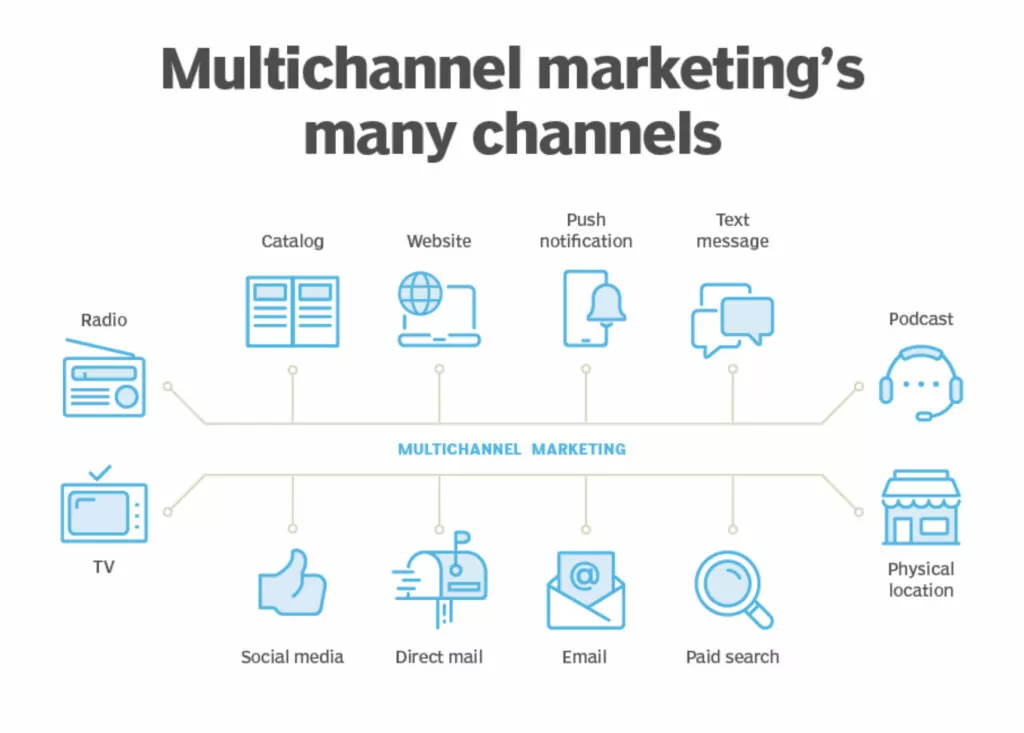When marketing over several channels, you face challenges when trying to attribute your final sales results to each contributing channel and touchpoint. However, analyzing your campaigns together is critical to fully understanding each channel’s impact on your return. That’s why establishing a strategy to measure multichannel marketing is the foundation of a successful campaign with high results.
Learn how your different channels impact your overall return and how to measure what each channel contributes to your multi-location marketing results.
Key Takeaways:
- Most customers interact with multiple channels in their buyer’s journey.
- Attribution models are different techniques for distributing your sales results between touchpoints to give every interaction credit for the sale.
- A custom attribution model uses your marketing data to assign custom values to each touchpoint according to its impact on a sale’s decision.
Is Multichannel Marketing Metrics Different from Traditional Metrics?
When you are working with multiple channels in your marketing, you’re also dealing with different types of results. For example, some of your channels are direct marketing campaigns where you can measure your results in sales and new leads.
However, other marketing channels are indirect, which require more complex tracking and measurements to see the return from those channels, like radio ads or blog posts.
In addition, multichannel marketing results are often siloed instead of interconnected like omnichannel marketing. For instance, 80.9% of US spending happens offline. Therefore, tracking your multichannel ROI can become more difficult because you can’t always see how some channels influence a buyer’s decision.
Roughly 86% of consumers will use at least two different channels when shopping. For example, a consumer might see a product on social media. This inspires a Google search where they click on a blog post entry about your brand. They like what they read and search for franchise locations near them. Then, the next day they visit a physical store where they purchase a product.
If you only looked at direct sales, you would attribute the physical store with making the sale. However, in reality, your social media, blog, and Google business page all played a role in that sale. That’s where an attribution model comes into play.
Source: TechTarget
How a Marketing Attribution Model Helps
A marketing attribution model takes all the touchpoints in a sale and divides the sales value between those channels to give each touchpoint credit for its role in the sale. You can use it to track and measure your results from your multichannel franchise marketing strategies.
Through marketing attribution, you know which channels are most successful in achieving your marketing goals and where you need to optimize your strategy.
There are six different attribution models you can use. Each one helps you measure results for specific goals. For instance, if you are looking for which of your channels has the highest conversion rate, you might use the last interaction model. However, if you want to assign a dollar value to each channel, you will use one of the other models that distribute sales between all the touchpoints in the buyer’s journey.
6 Attribution Models to Measure Multichannel Marketing Results
These six types of attribution models divide your financial return between each contributing channel in a percentage format for more accurate results.
Source: AgencyAnalytics
1. Last Interaction
The last interaction model attributes your sales to the last channel in the sales journey.
For example, if a consumer sees an ad for a product, searches for that product, then later sees it pop up in their social media feed, where they finally decide to purchase it, social media will receive 100% of the sales value.
When calculating your results, you will see social media as the most effective part of your multichannel marketing, but don’t account for the other touchpoints’ role. This model is good for measuring results to know which channels receive the most conversions. However, it doesn’t help you understand the total ROI of each channel along the way.
2. First Interaction
The first interaction model is the opposite of the last interaction model. Instead of attributing your sales to the last touchpoint, you attribute it to the channel that started the lead on their journey.
For example, a consumer might first see your product from a social media influencer video. You would attribute that conversion to the influencer’s promotion even if they had several other touchpoints before the sale.
First interaction works best for businesses that only have a few channels. For example, franchises wouldn’t be unable to accurately measure their results using the first interaction model because there are too many touchpoints to account for between the first interaction and a sale.
3. Last Non-Direct Click
The last non-direct click model focuses on what prompted a consumer to purchase a product rather than where they bought it. For example, a consumer might go to a website to purchase directly from a franchise. However, that website might not be responsible for convincing the customer to buy.
This model looks at the step before the direct click and attributes 100% of the sales to that channel. For instance, if the consumer saw a video on social media before going to the website to purchase, the video receives full credit for the conversion when measuring your results.
4. Linear
A linear model is the first option that divides your results between multiple channels instead of giving full credit to one channel. You must track the customer’s journey between all your channels for a linear model to be effective, which makes it challenging for multichannel marketing as not all touchpoints are connected or online.
Once you have a complete list of the channels a customer interacted with before purchasing, you equally distribute the sales between those channels, attributing the same results to each touchpoint.
5. Time Decay
The time decay model considers that not all channels have an equal impact on a consumer’s purchase. Therefore, each channel shouldn’t receive the same credit in their results. In the model, the first touchpoint receives less of the total sale attributed to it than the final touchpoint.
Using the time decay model, the channels directly before a sale will have greater results than the first touchpoints.
6. Position Based
The position-based model credits most of the sales to the first and last touchpoint while distributing the rest between the other channels. For example, if a customer heard about your franchise from an ad but went through several touchpoints before purchasing from a physical store, the ad and store would receive most of the credit for the sale.
Create Your Own Attribution Model
The six main attribution models are general overviews of measuring your results by distributing the value of a sale between channels. However, they don’t account for variances in marketing techniques and strategies.
Instead, consider creating a custom attribution model. A custom model assigns more significant value to certain channels when distributing your results between the touchpoints. This is the most effective model for measuring your multichannel marketing as you can account for channels that aren’t directly connected but still influence a consumer’s decision.
To create a custom model, you must first create a system for data collection where you can compile information from all your channels in one place. To ensure you’re collecting data from online and offline channels, send out customer surveys that ask how they heard about you.
After analyzing your data, you will see patterns that help you identify your most influential channels in the buyer’s journey. Then, you would assign the most significant value to those channels in your custom model.
Track Your Leads Across Channels
Which of your channels is performing best?
MXTR tracks your leads as they move across your marketing channels and provides the insights you need to create a custom model for measuring your results.
Schedule a demo to learn how our marketing automation tracks multichannel marketing.
Featured Image: istockphoto









